Asensio Velazquez. Sgt, Mil Discip Cab Arequipa, 1792. Leg 7284:XIII:36.
Cayetano Velazquez. Lt, Mil Prov Urbanas Dragones de Celendín, Partido de Cajamarca, 1797. Leg 7287:IX:17.
Enrique Velazquez. Sgt, Comp Vet de la Dotación de Chiloe, 1794. Leg 7285:II:14.
Felipe Velazquez. Sgt, 1st de la Comp de Tiabaya, Mil Discip Cab de Arequippa, 1792. Leg 7284:XIII:44.
Fermin Velazquez. Sgt, Comp Sueltas Inf partido de Calbuco, Chiloe, 1800. Leg 7288:V:14.
Francisco Velazquez. Sgt de la 4th Comp, Mil Prov Urbanas Dragones de Celendín Partido de Cajamarca, 1797. Leg 7287:IX:34.
Francisco Velazquez. Lt, Mil Prov Discip Inf de Castro,Chiloe, 1800. Leg 7288:IX:34.
Francisco Javier Velazquez. Lt, 1st Comp suelta Inf Discip San Carlos de Guapilacuy, Chiloe, 1800. Leg 7288:VIII:2.
Francisco Javier Velazquez. Sgt, Comp Vets de la Dotación de Chiloe, 1800. Leg 7288:XI:11.
José Velazquez. Lt, Mil Discip Dragones de Amotape, Piura, 1795. Leg 7285:XXIII:14.
José Velazquez. Cadet, Comp Vets de la dotación de Chiloe, 1800. Leg 7288:XI:12.
José María Mercedes Velazquez. Capt, Mil Prov Discip Cab del Valle de Chincha, 1797. Leg 7287:XII:7.
Juan Velazquez. Sgt, Mil Urbanas Inf de Moquegua, 1797. Leg 7287:XXVI:28.
Juan Antonio Velazquez. Cadet, Comp Vets de la dotación de Chiloe, 1800. Leg 7288:XI:14.
Juan Bautista Velazquez. Lt, Mil Prov Urbanas de Dragones de Celendín, Partido de Cajamarca, 1797. Leg 7287:IX:12.
Juan José Velazquez. Sgt, Comp Sueltas Inf, Partido de Calbuco, Chiloe, 1800. Leg 7288:V:11.
Antonio Velazquez y Loyola. Cadet, Bn Prov Mil Discip Inf Española de Lima, 1800. Leg 7288:XXIII:81.
JoséVelazquez y Loyola. Cadet, Inf Real de Lima, 1800. Leg 7288:XXII:132.
Nicolás Velez. Cadet, Mil Urbanas Inf de Moquegua, 1797. Leg 7287:XXVI:44.
Andrés Velez de Cordoba. Cadet, Mil Urbanas Inf de Moquegua, 1797. Leg 7287:XXVI:43.
Alfonso Velezmoro. Capt, grad Comandante, Mil Urbanas Cab San Pablo de Chalaquez, 1798. Leg 7287:XI:10.
Tomás Velezmoro. Capt, grad de Comandante, Mil Urbanas Cab San Pablo de Chalaquez, 1798. Leg 7287:XI:3.
José Velezmoro y Mieses. Dadet, Mil Prov Urbanas Inf de Cajamarca, 1797. Leg 7287:IV:38.
Juan Velezmoro y Mieses. Cadet, Mil Prov Urbanas Inf de Cajamarca, 1791. Leg 7284:I:44.
Matías Velis. Sgt, Mil Discip Cab de los valles de Palpa y Nasca, 1797. Leg 7287:XXXI:34.
Antonio Vera. Alf, Mil Prov Discip Dragones de Caraveli, 1796. Leg 7287:VIII:26.
Clemente Vera. Alf, Mil Prov Discip Cab del Cuzco, 1797. Leg 7287:X:28.
Federico Vera. Cadet, Momp Vet de la dotación de Chiloe, 1800. Leg 7288:XI:12.
Francisco Urbano Vera. Sgt, 1st, de Granaderos, Mil Prov Discip Inf de Castro, Chiloe, 1800. Leg 7288:IX:106.
Mariano Vera. Sgt, Mil Prov Discip Cab del Valle deChincha, 1797. Leg 7287:XII:34.
Pascual Vera. Sgt, Mil Prov Discip Inf de Castro Chiloe, 1800. Leg 7288:IX:82.
Pedro de Vera. Capt, Mil Prov Urbanas Dragones de Huambos Partido de Cajamarca, 1797. Leg 7287:XVII:9.
Gregorio Vera y Soto. Alf, Escuadrón Dragones de Pacasmayo, 1800. Leg 7288:XXVIII:5.
Manuel Verano. Lt, Mil Discip Cab de Hjaura, 1797. Leg 7287:XIX:10.
Manuel Verastegui. Sgt, Mil Prov Urbanas Inf de Cajamarca, 1792. Leg 7284:IV:40.
Manuel Leon de Verastegui. Capt, Comp Mil Discip Pardos de Cab del Regimiento de Ferreñafe, 1797. Leg 7287:XV:1.
Pablo Verdeguer y Ramos. Col, Comp sueltas, Mil Urbanas Inf de Anco, 1797. Leg 7287:I:1.
José Vergara. SubLt de Granaderos, Bn Prov Mil de Pardos Libes de Lima, 1796. Leg 7286:XII:37.
José Eusebio Vergara. Cadet, Inf Real de Lima, 1800. Leg 7288:XXII:120.
Lucas de Vergara. Lt Col, Bn Prov Mil Discip Inf Española de Lima, 1800. Leg 7288:XXIII:6.
Juan José Verger. Capt, Mil Prov Urbanas Inf de Cajamarca, 1797. Leg 7287:IV:4.
Luis Veyan. Cadet, Inf Real de Lima, 1790. Leg 7283:VIII:127.
Antonio Viana y Picoaga. Lt, Mil Prov Urbanas Dragones de Quispicanchi, Cuzco, 1798. Leg 7286:XX:13.
Bernardo Vicuña. Portaguión, Mil Dragones Prov de las Fronteras de Tarma, 1800. Leg 7288:XXIX:34.
Manuel Vicuña. Sgt, Mil Discip Cab de los Valles de Palpa y Nasca, 1797. Leg 7287:XXXI:36.
Alberto Vidal. Lt, Mil Prov Discip Inf de Castro, Chiloe, 1800. Leg 7288:IX:30.
Francisco Vidal. SubLt, Mil Prov Discip Inf de Castro, Chiloe, 1800. Leg 7288:IX:56.
Juan de Dios Vidal. Lt, Mil Prov Discip Inf de Castro, Chiloe, 1800. Leg 7288:IX:36.
Juan Vidalon. Capt, Mil Urbanas Inf de Huancavelica, 1801. Leg 7286:XVI:6.
Gregorio José Vidaurre. Lt Col, Mil Discip Cab de Ferreñafe, 1797. Leg 7287:XIV:2.
Romualdo Vidaurre. Col, Mil Discip Cab de Ferreñafe, 1797. Leg 7287:XIV:1.
José Vidurrezaga. Col, Mil Prov Inf de Huánuco, 1796. Leg 7286:V:2.
Dionisio Vilches. Lt, Mil Discip Cab de Arequipa, 1792. Leg 7284:XIII:19.
José Vilches. Sgt, Mil Discip Cab de Ferreñafe, 1797. Leg 7287:XIV:42.
Juan Vilches. Sgt, 1st de Granaderos, Inf Real de Lima, 1790. Leg 7283:VIII:98.
Pedro Vilela. Sgt, Mil Discip Dragones de la ciudad de Piura, 1795. Leg 7285:XXIII:23.
Vicencio Vilela. Alf, Escuadrones Cab Mil de los territorios de Huancabamba y Chalaco, Piura, 1797. Leg 7287:XXXIV:10.
Lorenzo Villa. Alf, Mil Discip Cab Arnero de Chancay, 1800. Leg 7288:III:20.
Santiago Villacorta. SubLt, Mil Inf Española de San Juan de la Frontera de Chachapoya, 1792. Leg 7284:VI:30.
Antonio Villaespesa. Sgt Mayor, Mil Urbanas de Inf de Huancavelica, 1800. Leg 7288:XVI:3.
José Antonio de Villaespesa. Cadet, Mil Urbanas de Inf de Huancavelica, 1800. Leg 7288:XVI:28.
Juan VillaFuerte. Sgt, Mil Prov Urbanas de Dragones de Quispicanchi, Cuzco, 1798. Leg 7286:XX:38.
Mariano de Villafuerte. Lt, Mil Discip de Inf de Cuzco, 1800. Leg7286:XXIV:29.
Marqués de Villafuerte. Col, Cab Mil Discip de Arnero, Chancay, 1800. Leg 7288:III:1.
Martin Mariano Villafuerte. Sgt, Mil Prov Urbanas de Dragones de Quispicanchi, Cuzzco, 1798. Leg 7286:XX:33.
José Villagomez. SubLt, Inf Real de Lima, 1796. Leg 7287:XXIV:9.
Mariano Villalba. Lt, Mil Urbanas Inf de Andahuaylas, 1799. Leg 7286:XXII:12.
José Hermenegildo Villalobos. Portaestandarte, Mil Discib Cab de Ferreñafe, 1797. Leg 7287:XIV:6.
Luis Villalobos. Alf, Mil Prov Urbanas Dragones de Huambos, Partido de Cajamarca, 1797. Leg 7287:XVII:18.
Manuel Villalobos. Sgt, Mil Discip Cab Arnero de Chancay, 1800. Leg 7288:III:31.
Juan Antonio de Villalobos y Burga. Lt, Mil Prov Urbanas Dragones de Huambos, Partido de Cajamarca, 1797. Leg 7287:XVII:15.
Domingo de Villanueva. Lt, Mil Prov Discip de Cab de Arequipa, 1797. Leg 7287:II:27.
José Villanueva. Sgt de Granaderos, Mil Prov Urbanas de Dragones de Chota, 1797. Leg 7287:XIII:42.
Marcelo Villanueva. Capt, Mil Prov urbanas de Inf de San Antonio de Cajamarca, 1797. Leg 7287:III:5.
Francisco Villar. SubLt, Mil Prov Urbanas Inf de Abancay, 1793. Leg 7284:II:58.
Francisco del Villar. Lt Col, Mil Discip Cab de Ica, 1797. Leg 7287:XX:2.
Juan del Villar. Sgt, Mil Prov Urbanas Dragones de Celendín, Partido de Cajamarca, 1792. Leg 7284:XV:39.
Juan Bautista Villasaso. Lt, Mil Discip Dragones de Arica, 1795. Leg 7285:XI:32.
José Antonio Villavicencio. Cadet, Mil Prov Urbanas Cab de Huanta, 1794. Leg 7285:III:46.
Julián Ville. SubLt, Inf Real de Lima, 1793. Leg 7284:IX:70.
Alonso Villegas. Capt, Mil Urbanas Inf de Huancavelica, 1800. Leg 7288:XVI:5.
José Villegas. Capt, Mil Prov Discip Dragones del Valle de Majes, 1797. Leg 7287:XXV:9.
Julián Villegas. SubLt, Inf Real de Lima, 1800. Leg 7288:XXII:59.
Justo Villegas. SubLt, Comp sueltas de Milicias Discip Cab de Calbuco, Chiloe, 1800. Leg 7288:VI:3.
Nicolás Villegas. SubLt, Comp sueltas Inf, Partido de Calbuco, Chiloe, 1800. Leg 7288:V:10.
Rafael Villegas. Lt, Mil Prov Discip If de Castro, Chiloe, 1800. Leg 7288:IX:46.
Ignacio Villena. Sgt, Mil Urbanas Cab San Pablo de Chalaquez, 1798. Leg 7287:XI:41.
Rafael Vitoria. Sgt, Mil Prov Urb Cab de Huanta, 1798. Leg 7286:XVII:26.
Alejo Vivanco. SubLt, Mil Prov Urbanas Inf de Huanta, 1800. Leg 7288:XVIII:51.
Antonio Vivanco. SubLt, Mil Prov Urbanas Inf de Huanta, 1800. Leg 7288:XVIII:50.
Silverio Vivanco. Lt, Mil Urbanas Inf de Huancavelica, 1800. Leg 7288:XVI:11.
Agustín Vivancos. Alf, Mil Discip Dragones de Lima, 1800. Leg 7288:XXIV:55.
José Vivancos. Sgt, Mil prov Urbanas Cab de Huanta, 1798. Leg 7286:XVII:28.
Juan Vives Echevarria. Capt, grad Lt Col, Bn Prov Mil Discip Inf Española de Lima, 1800. Leg 7288:XXIII:21.
Matías Yabar. Capt, Inf Real Asiento de Paucartambo, 1798; Leg 7286:XIX:8
Narciso Yabar. SubLt de Granaderos, Inf del Real Asiento de Paucartambo, 1798k Leg 7286:XIX:25.
Manuel Yanse. Cadet, Mil Prov Urbanas Cab de Huanta, 1798. Leg 7286:XVII:33.
Antonio Yañez. Portaestandarte, Mil Discip Cab de Camaná, 1798. Leg 7286:XIV:23.
José Félix Yañez. Cadet, Mil Discip Dragones de Arica, 1800. Leg 7288:II:64.
Manuel Yañez. Portaguión, Mil Discip Dragones de Arica, 1800. Leg 7288:II:39.
Cristóbal Yarza. Lt de granaderos Comp sueltas Mil Discip Inf de Trujillo, 1794. Leg 7286:X:8.
Ildefonso de Yepes. Capt, Mil Prov Urbanas Dragones de Quispicanchi, Cuzco, 1798. Leg 7286:XX:8.
Gabriel Zabala. Sgt, Mil Discip Dragones de Arica, 1800. Leg 7288:II:55.
Juan José Zabala. Portaguión, Mil Discip Dragones de Arica, 1800. Leg 7286:II:38.
Manuel Zabala. Alf, Mil Prov Discip Cab del Valle de Chincha, 1797. Leg 7287:XII:23.
Pedro Zabala. Sgt, Mil Discip Dragones de Arica, 1800. Leg 7288:II:58.
Pedro José Zabala, Marqués de Valle Umbroso. Lt, Mil Discip Dragones de Lima, 1800. Leg 7288:XXIV:43.
Juan Bautista Zafra. Sgt, 1st de Granaderos, Comp Sueltas Mil Discip Inf de Trujillo, Perú, 1800. Leg 7288:XXX:12.
Francisco Valdivia. Capt, Mil Prov Discip Inf de Casro, Chiloe, 1800. Leg 7288:IX:4.
José Valdivia. Lt, Mil Prov Discip Inf de Castro, Chiloe, 1800. Leg 7288:IX:43.
Pedro Valdivia. Lt, 2d Comp Ind Discip de San Carlos de Quetalmahue, Chiloe, 1800. Leg 7288:VII:2.
Francisco de Zaldua. Lt, Comp sueltas Mil Discip Inf de Ica, 1800. Leg 7288:XIX:9.
Carlos Zamalloa. Capt, Inf del Real Asiento de Paucartambo, 1798, Leg 7286:XIX:15.
Diego Zamalloa. Capt, Inf del Rea Asiento de Paucartambo, 1798. Leg 7286:XIX:13.
Manuel Zamalloa. Lt, Inf del Real Asiento de Paucartambo, 1798. Leg 7286:XIX:19.
Santiago Zamalloa. Lt, Inf del Real Asiento de Paucartambo, 1798. Leg 7286:XIX:21.
Manuel Zambrano. Cadet, Bn Prov Mil Discip Inf Española de Lima, 1794. Leg 7285:VIII:56.
José Antonio Zamora. Sgt, Escuadrón de Dragones de Pacasmayo, 1800. Leg 7288:XXVIII:7.
Manuel Samudio. Capt, Mil Discip de Pardos y Morenos de Inf de Lambayeque, 1797. Leg 7287:XXIII:4.
Antonio Zañartu. Capt, Mil Prov Urbanas de Cab de Huamalies, 1797. Leg 7287:XVI:9.
Buenaventura Zañartu del Fierro. Capt, Mil Prov Discip Inf de Arequipa, 1800. Leg 7288:I:19.
Agustín Zapata. SubLt, Escuadrón de Cab de Mil Urbanas de Moquegua, 1800. Leg 7288:XXVII:9.
José Zapata. Lt, Inf Real de Lima, 1800. Leg 7288:XXII:39.
Santiago Zapata. SubLt, Escuadrón de Cab de Mil Urbanas de Moquegua, 1800. Leg 7288:XXVII:10.
Francisco de Zarate. Comandante, Mil Discip de Dragones de Lima, 1800. Leg 7288:XXIV:4.
Jacinto Zarate. Sgt, Inf del Lreal Asiento de Paucartambo, 1798. Leg 7286:XIX:30.
José de Zarate, Marqués de Montemira. Col, Brigadier, Mil Discip de Dragones de Lima, 1800. Leg 7288:XXIV:1.
Lorenzo de Zarate. Alf, Mil Discip Dragones de Lima, 1792. Leg 7284:XIX:63.
Vicente Zarate. Sgt, Inf Real de Lima, 1800. Leg 7288:XXII:104.
Lorenzo de Zarate Manrique de Lara. Cat, Mil Discip de Dragones de Lima, 1800. Leg 7288:XXIV:18.
Cristóbal de Zavala. Col, Mil Prov Urbanas Cab de Huánuco, 1797. Leg 7286:VI:1.
Jorge Zavala. Alf, Mil Discip Cab de Camaná, 1795. Leg 7285:XII:25.
José Agustín Zavala. Cadet, Inf Real de Lima, 1800. Leg 7288:XXII:134.
Miguel Zavala. Sgt, Comp Sueltas de Mil Discip de Inf de Trujillo, Perú, 1800. Leg 7288:XXX:11.
Nicolás Zavala. Lt, Mil Prov Urbanas de Inf de Cajamarca, 1797. Leg 7287:IV:8.
Nicolás Zavaleta. Capt, Mil Prov Urbanas de Dragones de Celendín, Partido de Cajamarca, 1797. Leg 7287:IX:6.
Manuel de Zendagorta. Lt, Mil Urbanas de Dragones de Palma, Partido de Jauja, 1800. Leg 7288:XXI:17.
Pedro Zoilo. Cadet, Inf Real de Lima, 1793. Leg 7284:IX:109.
Basilio Antonio Zorrilla. SubLt, Mil Prov Discip Inf de Arequipa, 1800. Leg 7288:I:57.
Eugenio Zorrilla. Lt, Mil Discip de Cab de Ica, 1800. Leg 7288:XX:15.
Francisco Zorrilla. Lt, Mil Urbanas de Inf de Huancavelica, 1800. Leg 7288:XVI:9.
Pedro Zorrilla. Lt, Mil Urbanas de Inf de Huancavelica, 1800. Leg 7288:XVI:10.
Andrés Zuaznabar. Sgt, Mil Prov Urbanas de Cab de Huanta, 1798. Leg 7286:XVII:32.
Anselmo Zuaznabar. Lt, Mil Prov Urbanas de Cab de Huanta, 1798. Leg 7286:XVII:11.
Faustino Zuazo. Sgt, Comp Inf y Cab de Morenos Libres de Lima, 1800:Leg 7288:XXVI:3.
Mauricio Zuazo. Lt Col, Mil Discip Cab de Arnero de Chancay, 1800. Leg 7288:III:2.
Juan José Zubiate. Capt, Mil Inf Española de San Juan de la Frontera de Chachapoyas, 1792. Leg 7284:VI:6.
Bartolomé Zubiri. Alf, Mil Prov Discip de Cab de Arequipa, 1797. Leg 7287:II:47.
Bartolomé Zulueta. Sgt, Mil Prov Urbanas Dragones de Huambos, Partido Cajamarca, 1797. Leg 7287:XVII:35.
José Martín Zulueta. Alf, Mil Prov Discip Cab d Arequipa, 1797. Leg 7287:II:40.
Francisco Zumaran. Lt, Mil Prov Urbanas de Dragones de Carabayllo, 1797. Leg 7287:VII:18.
Gregorio Zuñiga. Capt, Mil Prov Urbanas de Inf de Calca, 1797. Leg 7287:V:7.
Juan Isidro Zuñiga. Lt Col, Mil Prov Discip de Dragones del Valle de Majes, 1797. Leg 7287:XXV:1 bis.
Manuel Zuñiga. Sgt 1st Granaderos Mil Prov Discip de Dragones del Valle de Majes, 1797. Leg 7287:XXV:31.
Miguel de Zuñiga. Capt de Granaderos, Mil Prov Urbanas de Dragones de Quispicanchi, Cuzco, 1798. Leg 7286:XX:6.
Miguel Zuñiga. Capt, Comp Sueltas Inf, Partido de Calbuco, Chiloe, 1800. Leg 7288:V:3.
Tomás Zuñiga. Sgt, Mil Prov Urbanas de Inf de Calca, 1797. Leg 7287:V:24.
Manuel José Zuñiga y Cea. Alf, Mil Prov Discip de Cab de Arequipa, 1797. Leg 7287:II:36.
Pedro Mariano de Zuzunaga. SubLt, Mil Prov Discip Inf de Arequipa, 1792. Leg 7284:III:58.
(end of patriots of the Viceroyalty of Peru during the American Revolutionary War.)
|
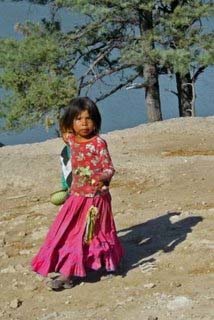 I
had read about this wonderful train ride that originated in
Chihuahua, Chihuahua probably about fifteen or twenty years
ago. I knew that was a trip I had to take, but other things
in my life were going on, and that trip was placed in the
backburner of my mind. Even in retirement, it seems other
events took precedence, but early in 2007 I decided that if
I didn't do that trip, I might not get to do it at all.
I
had read about this wonderful train ride that originated in
Chihuahua, Chihuahua probably about fifteen or twenty years
ago. I knew that was a trip I had to take, but other things
in my life were going on, and that trip was placed in the
backburner of my mind. Even in retirement, it seems other
events took precedence, but early in 2007 I decided that if
I didn't do that trip, I might not get to do it at all.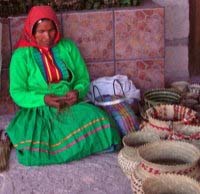 The
train ride was nice, the scenery impressive, but I was
especially intrigued by the Tarahumara Indians. The women
weave these wonderful baskets using pine tree needles. The
children sell trinkets to the tourists. Many of the men
still wear their native dress even though the Mexicans in
town wear modern dress.
The
train ride was nice, the scenery impressive, but I was
especially intrigued by the Tarahumara Indians. The women
weave these wonderful baskets using pine tree needles. The
children sell trinkets to the tourists. Many of the men
still wear their native dress even though the Mexicans in
town wear modern dress.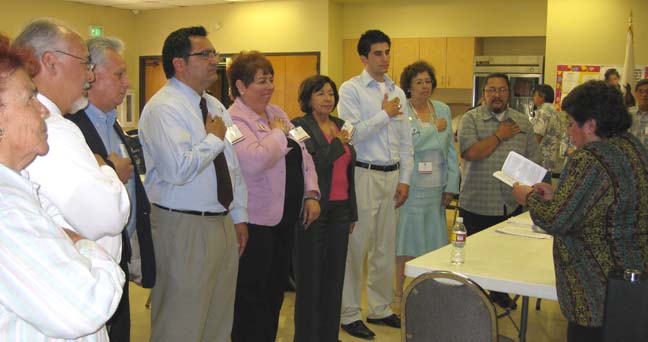
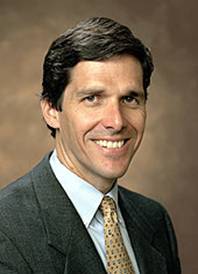
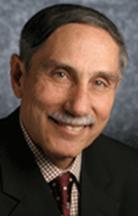
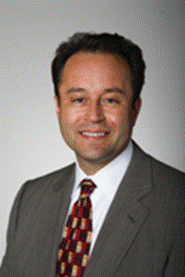
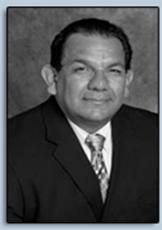
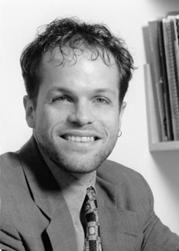
 StoryCorps
, a national initiative to document
everyday history and the unique stories of Americans, is in Salt Lake during
the month of April as part of its cross-country tour.
StoryCorps
, a national initiative to document
everyday history and the unique stories of Americans, is in Salt Lake during
the month of April as part of its cross-country tour.
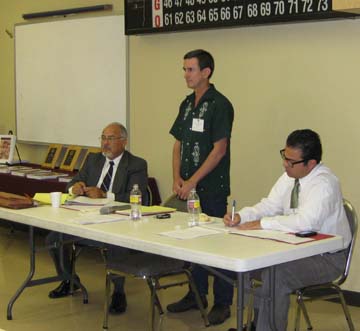 Guest speakers were Michael Marsh
(standing in photo), Director of the Agricultural Worker Health Project (AWHP) of
California rural Legal Assistance (CRLA). Michael works from the
Salinas office of CRLA, which has twenty-two offices through-out rural
California. Dr. Erualdo Romero Gonzalez, Assistant
Professor in the Chicana and Chicano Studies Department at California
State University, Fullerton. His expertise is in the area of
environmental health, special focus on Latino needs. The
discussion was centered on both the health problems associated with
farm work, and employment opportunities for Latinos in alternate
energy industries.
Guest speakers were Michael Marsh
(standing in photo), Director of the Agricultural Worker Health Project (AWHP) of
California rural Legal Assistance (CRLA). Michael works from the
Salinas office of CRLA, which has twenty-two offices through-out rural
California. Dr. Erualdo Romero Gonzalez, Assistant
Professor in the Chicana and Chicano Studies Department at California
State University, Fullerton. His expertise is in the area of
environmental health, special focus on Latino needs. The
discussion was centered on both the health problems associated with
farm work, and employment opportunities for Latinos in alternate
energy industries.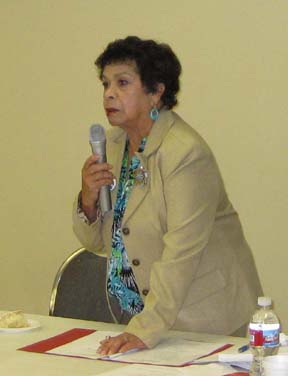 Lola
Gallardo, long time member.
Lola
Gallardo, long time member.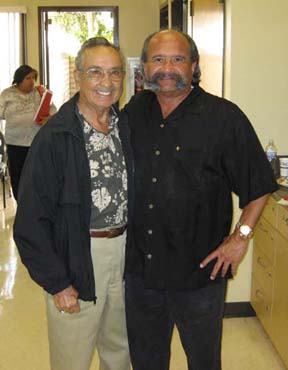
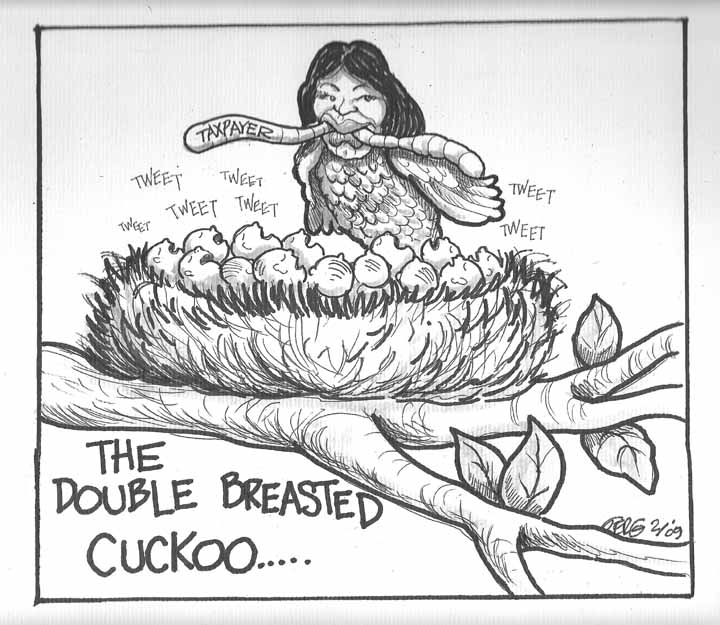
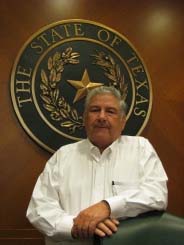
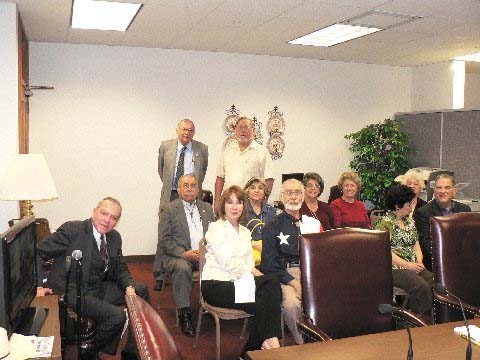
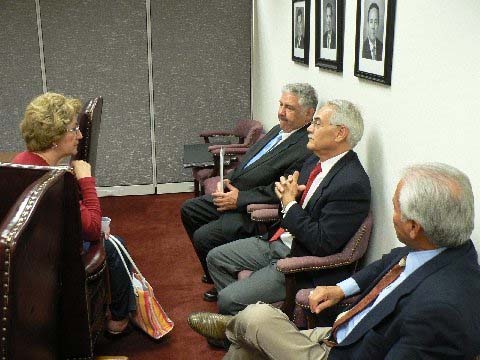
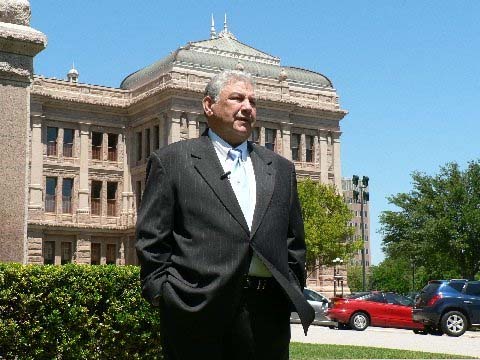

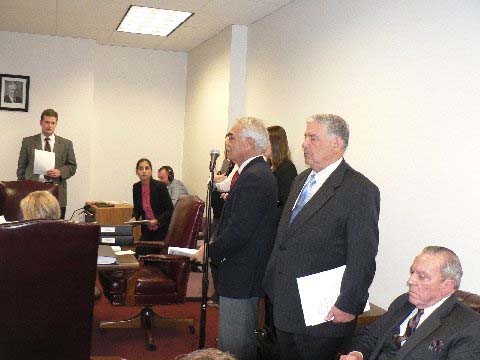
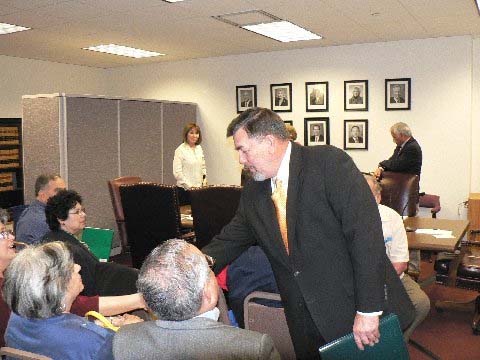
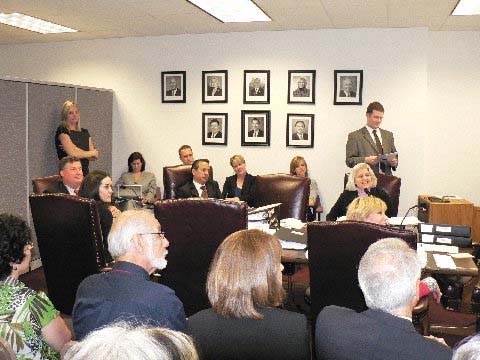
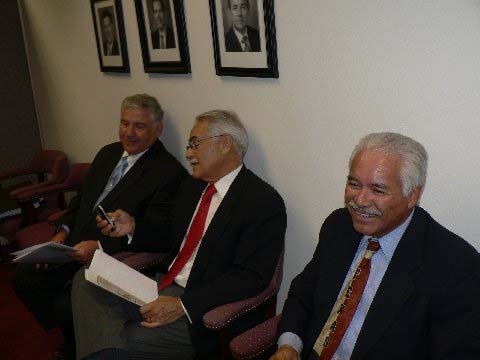
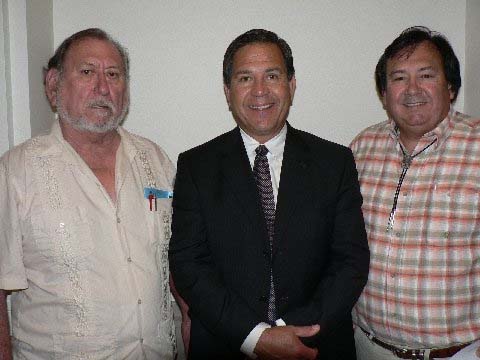
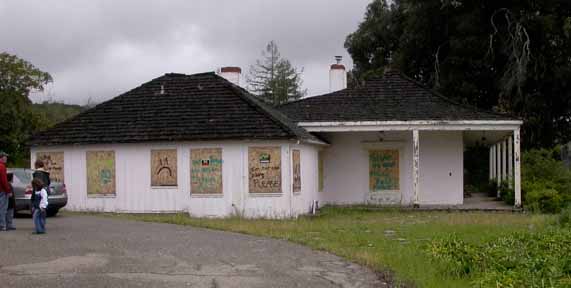
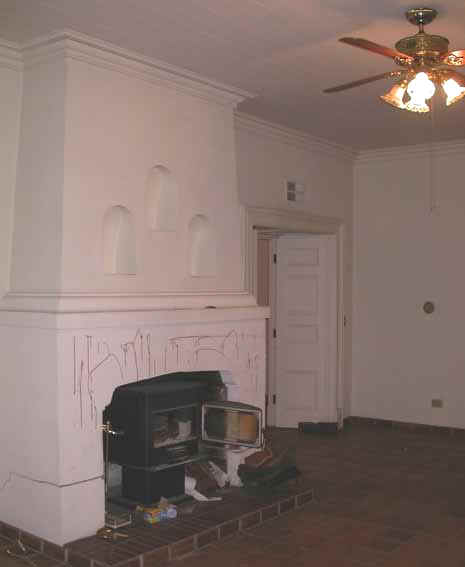 Personally,
I was so distressed by the sight I could barely contain my anger
and sadness. I always thought I'd never see it. Instead, I saw
what was presented SOMEWHAT as a rotting corpse of a house, that
actually is in good condition if you strip away the added
materials of the last 124 years. . Not only has the place been
vandalized, but when I questioned the developer of his plans, I
saw little inkling of respect for the integrity of the site beyond
the single building itself. He was a friendly and accomodating
man, but I don't think history is on his mind. I asked his where
the nearest homes would be, and you could toss a softball and hit
them from the front porch.
Personally,
I was so distressed by the sight I could barely contain my anger
and sadness. I always thought I'd never see it. Instead, I saw
what was presented SOMEWHAT as a rotting corpse of a house, that
actually is in good condition if you strip away the added
materials of the last 124 years. . Not only has the place been
vandalized, but when I questioned the developer of his plans, I
saw little inkling of respect for the integrity of the site beyond
the single building itself. He was a friendly and accomodating
man, but I don't think history is on his mind. I asked his where
the nearest homes would be, and you could toss a softball and hit
them from the front porch.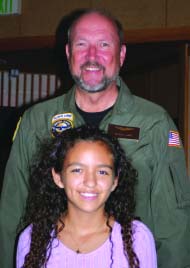 Breean Farfan isn't old enough to drive to the Compton airport
from her home in Bellflower, but the flying Farfan piloted 31hours to Oshkosh, Wis. and back. She reached her lofty goal of
flying to Wisconsin and attending the Experimental Aircraft
Association's (EAA) Young Eagles Camp with some hard work
and support from her family.
Breean Farfan isn't old enough to drive to the Compton airport
from her home in Bellflower, but the flying Farfan piloted 31hours to Oshkosh, Wis. and back. She reached her lofty goal of
flying to Wisconsin and attending the Experimental Aircraft
Association's (EAA) Young Eagles Camp with some hard work
and support from her family. 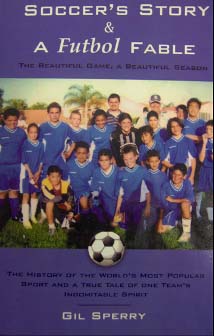
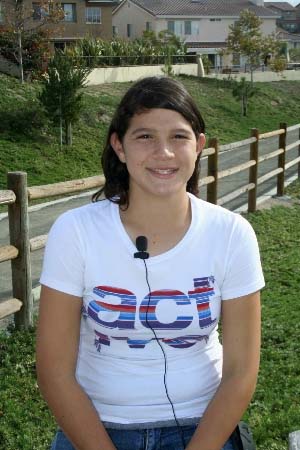 With only a few short exercise periods, Sperry evaluated students on their soccer skills. Only three students’ skills showed potential and two of them were not even interested in trying out for the team. Sperry went ahead with tryouts and comprised a twenty member team including thirteen fourth and fifth graders and five girls.
With only a few short exercise periods, Sperry evaluated students on their soccer skills. Only three students’ skills showed potential and two of them were not even interested in trying out for the team. Sperry went ahead with tryouts and comprised a twenty member team including thirteen fourth and fifth graders and five girls.




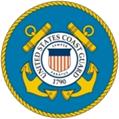
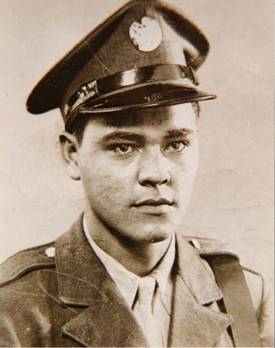
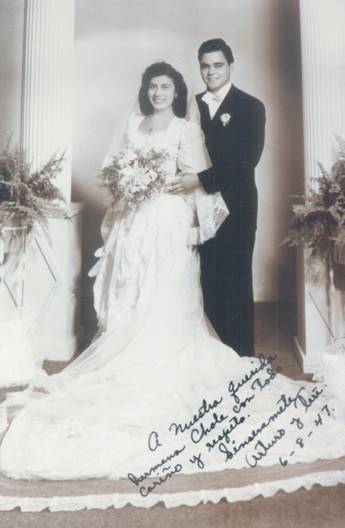
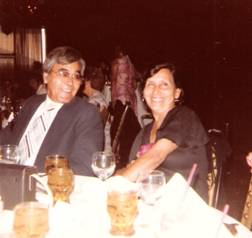
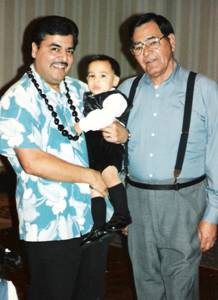
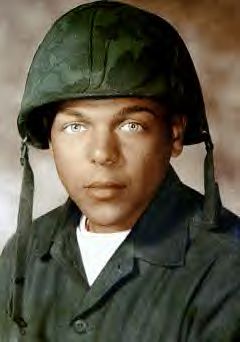
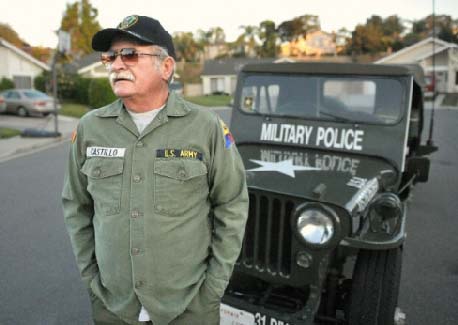 Tales says Sam did a nice job restoring his Jeep, but it's still a
primitive vehicle – with vacuum windshield wipers that quit when
going uphill; an engine that leaks oil; and a transmission transfer
case that's pitted and rusted.
Tales says Sam did a nice job restoring his Jeep, but it's still a
primitive vehicle – with vacuum windshield wipers that quit when
going uphill; an engine that leaks oil; and a transmission transfer
case that's pitted and rusted.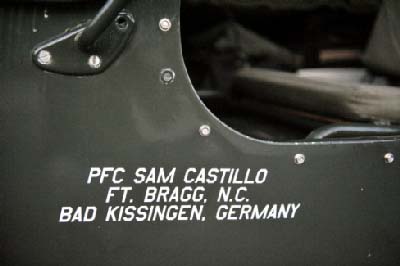 He began telling his wife, Marie, about his plans. "Sure,
sure," she said.
He began telling his wife, Marie, about his plans. "Sure,
sure," she said.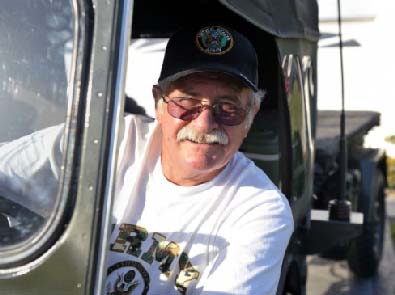 "He'll do the work nobody else wants to do," says Gwen
Wieser, confirmation coordinator at St. Nicholas Catholic Church in
Laguna Woods. "His sincerity comes out in his actions."
"He'll do the work nobody else wants to do," says Gwen
Wieser, confirmation coordinator at St. Nicholas Catholic Church in
Laguna Woods. "His sincerity comes out in his actions." When Sam reaches the Capitol he'll knock on doors and see who
answers. In his pocket will be that small steel nut he found outside
the Capitol stairs – a reminder of the promise he made five years
ago. And a reminder of his Uncle Danny, who was buried with shrapnel
in his arm but never heard anyone say, "Thank you for your
service."
When Sam reaches the Capitol he'll knock on doors and see who
answers. In his pocket will be that small steel nut he found outside
the Capitol stairs – a reminder of the promise he made five years
ago. And a reminder of his Uncle Danny, who was buried with shrapnel
in his arm but never heard anyone say, "Thank you for your
service." My
great, great uncle was (in Spanish) General Antonio Lopez de Santa
Anna. (a quick beat, a wry smile) I'm not kidding. The one from the
Alamo. (offhanded) And he also was president of Mexico three or four
times, I lose track. So our family's "been in the history
business" a long time.
My
great, great uncle was (in Spanish) General Antonio Lopez de Santa
Anna. (a quick beat, a wry smile) I'm not kidding. The one from the
Alamo. (offhanded) And he also was president of Mexico three or four
times, I lose track. So our family's "been in the history
business" a long time.
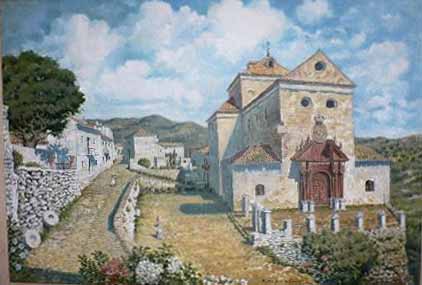
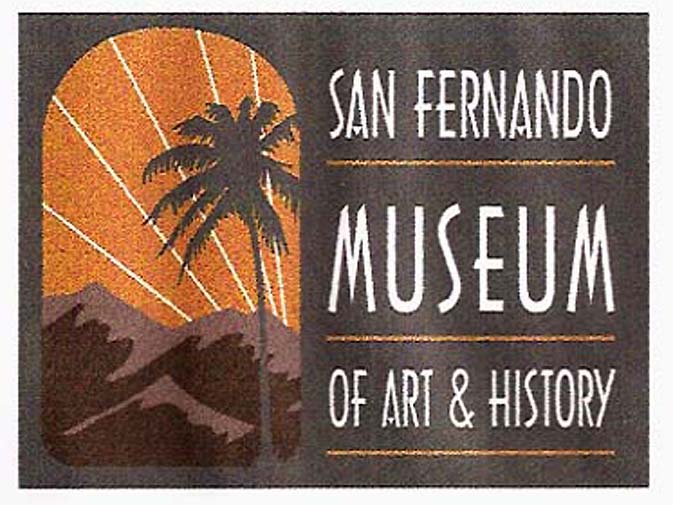

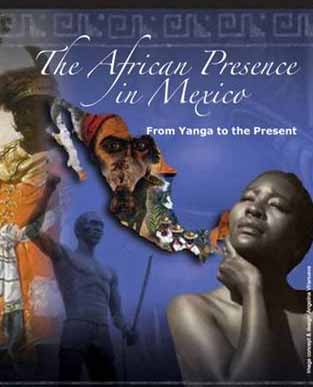
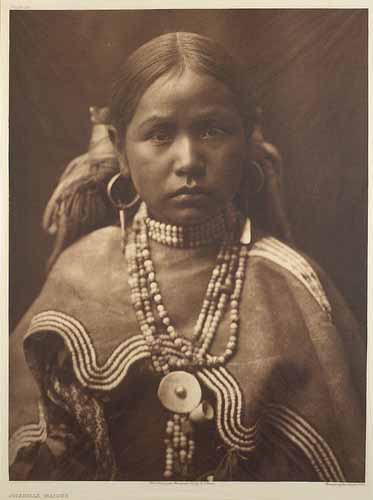

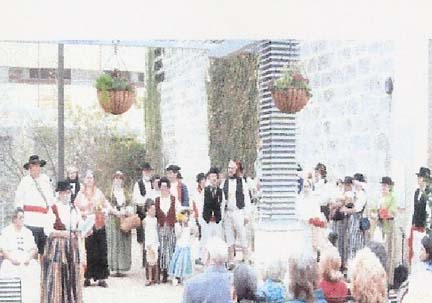
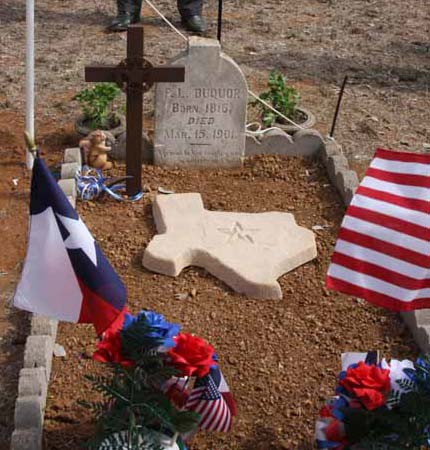
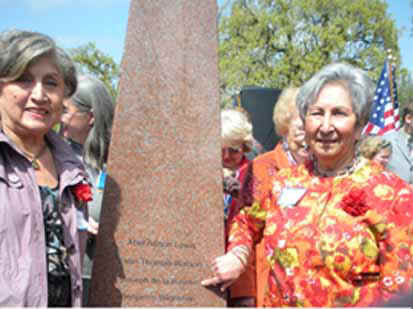
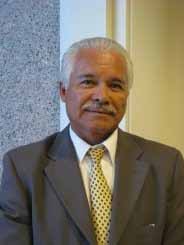 AUSTIN, April 15 - When historian Dan Arellano first tried to explain that Texas’ battle for independence from Mexico did not start at the Alamo he struggled to get heard. Now he is paid to do so.
On a visit to the state Capitol on Tuesday, Arellano offered a couple of examples of how the Establishment in Texas is now paying attention to his work.
AUSTIN, April 15 - When historian Dan Arellano first tried to explain that Texas’ battle for independence from Mexico did not start at the Alamo he struggled to get heard. Now he is paid to do so.
On a visit to the state Capitol on Tuesday, Arellano offered a couple of examples of how the Establishment in Texas is now paying attention to his work. 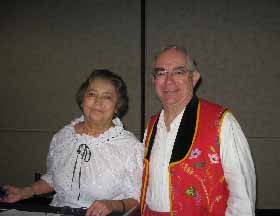
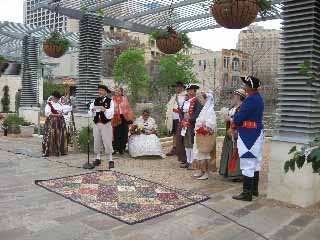
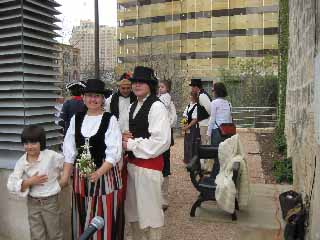
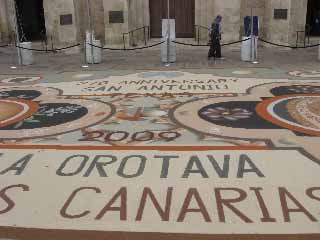
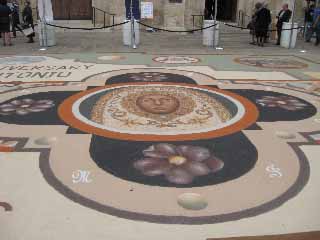
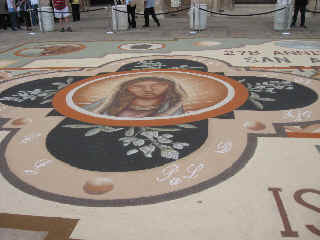
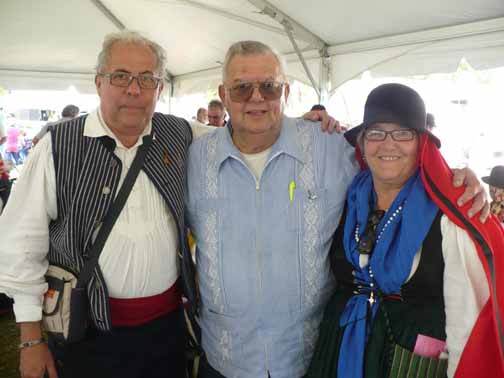
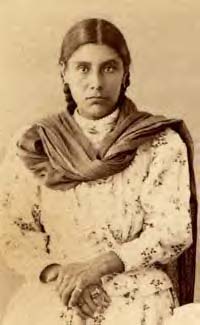 Since 1998 MexicoGenWeb has been a
free, non-profit, non-commercial, all-volunteer organization providing access to genealogical and historical records, and offering a place for people to connect and share information with each other about their Mexican heritage. MexicoGenWeb, a project of WorldGenWeb, first appeared online December 6, 1998 and was sponsored by Mike Jarvis, of Tucson, Arizona, USA.
Since 1998 MexicoGenWeb has been a
free, non-profit, non-commercial, all-volunteer organization providing access to genealogical and historical records, and offering a place for people to connect and share information with each other about their Mexican heritage. MexicoGenWeb, a project of WorldGenWeb, first appeared online December 6, 1998 and was sponsored by Mike Jarvis, of Tucson, Arizona, USA. The success with my Texas family inspired me to search for the family of our adopted son who is of Mexican heritage. After years of searching I found that my son's people came out of Chihuahua, Mexico, through El Paso, settling in Los Angeles County, California. We have met my son's grandparents and cousins and this reunion has added a great deal to all of our lives. It was my gratitude to the MexicoGenWeb project that moved me to volunteer to be the coordinator of the State of Chihuahua, and then a co-coordinator of Mexico with my partner Rosanna
Parra.
Volunteer State Coordinator, Teresa Sitz
The success with my Texas family inspired me to search for the family of our adopted son who is of Mexican heritage. After years of searching I found that my son's people came out of Chihuahua, Mexico, through El Paso, settling in Los Angeles County, California. We have met my son's grandparents and cousins and this reunion has added a great deal to all of our lives. It was my gratitude to the MexicoGenWeb project that moved me to volunteer to be the coordinator of the State of Chihuahua, and then a co-coordinator of Mexico with my partner Rosanna
Parra.
Volunteer State Coordinator, Teresa Sitz 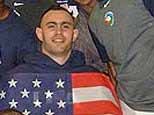
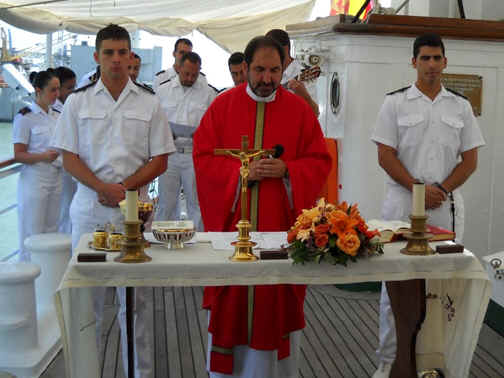
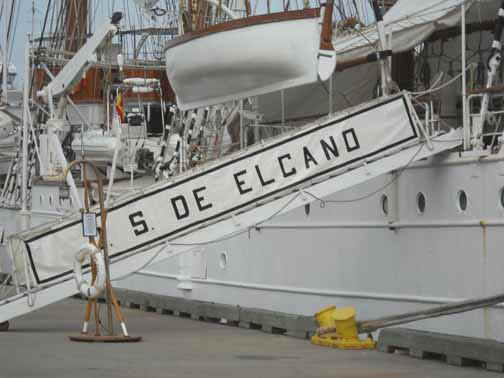 Here is some background on the schooner and who it was named after:
Juan Sebastian de Elcano Spain's 370 Foot Topsail schooner was launched in 1927 for the then Royal Spanish Navy. She is named after the Spanish seafarer Juan Sebastian de Elcano. and has circumnavigated the world six times. This four
masts schooner is the official training ship for the Spanish Navy.
Here is some background on the schooner and who it was named after:
Juan Sebastian de Elcano Spain's 370 Foot Topsail schooner was launched in 1927 for the then Royal Spanish Navy. She is named after the Spanish seafarer Juan Sebastian de Elcano. and has circumnavigated the world six times. This four
masts schooner is the official training ship for the Spanish Navy.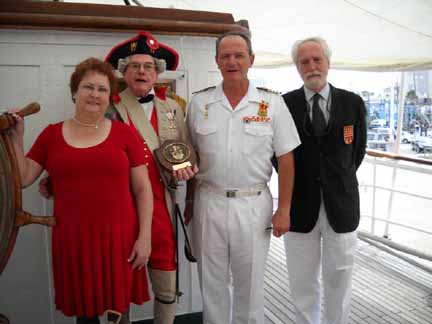
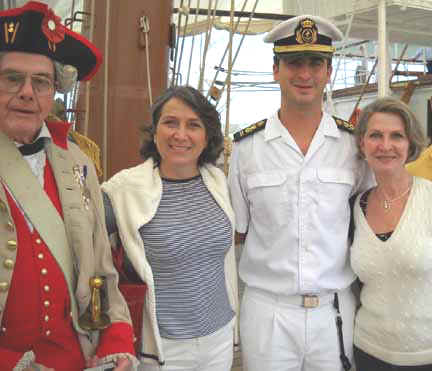
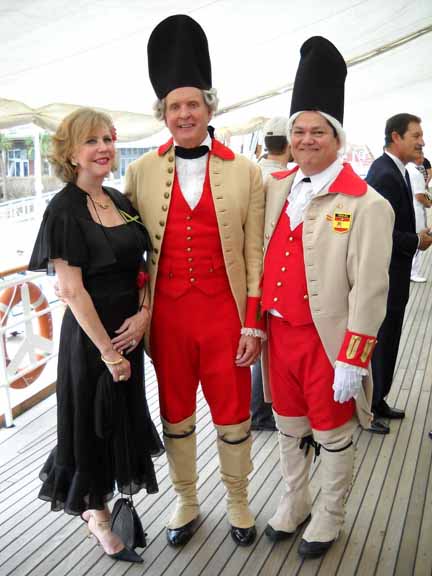
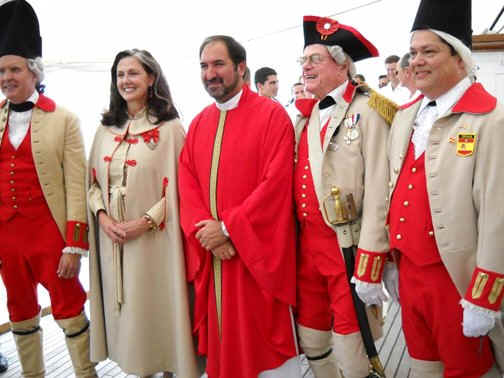
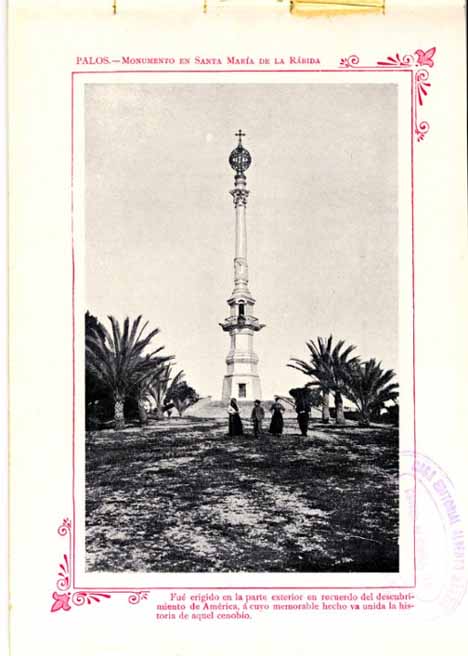
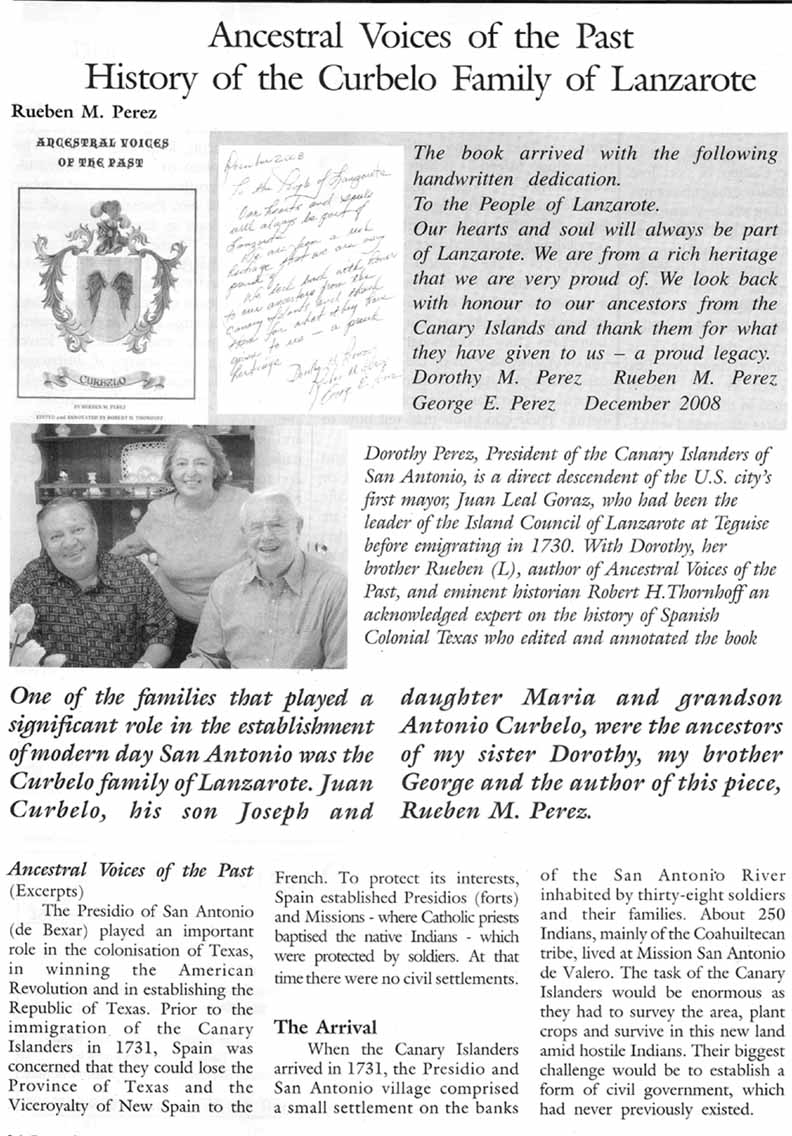
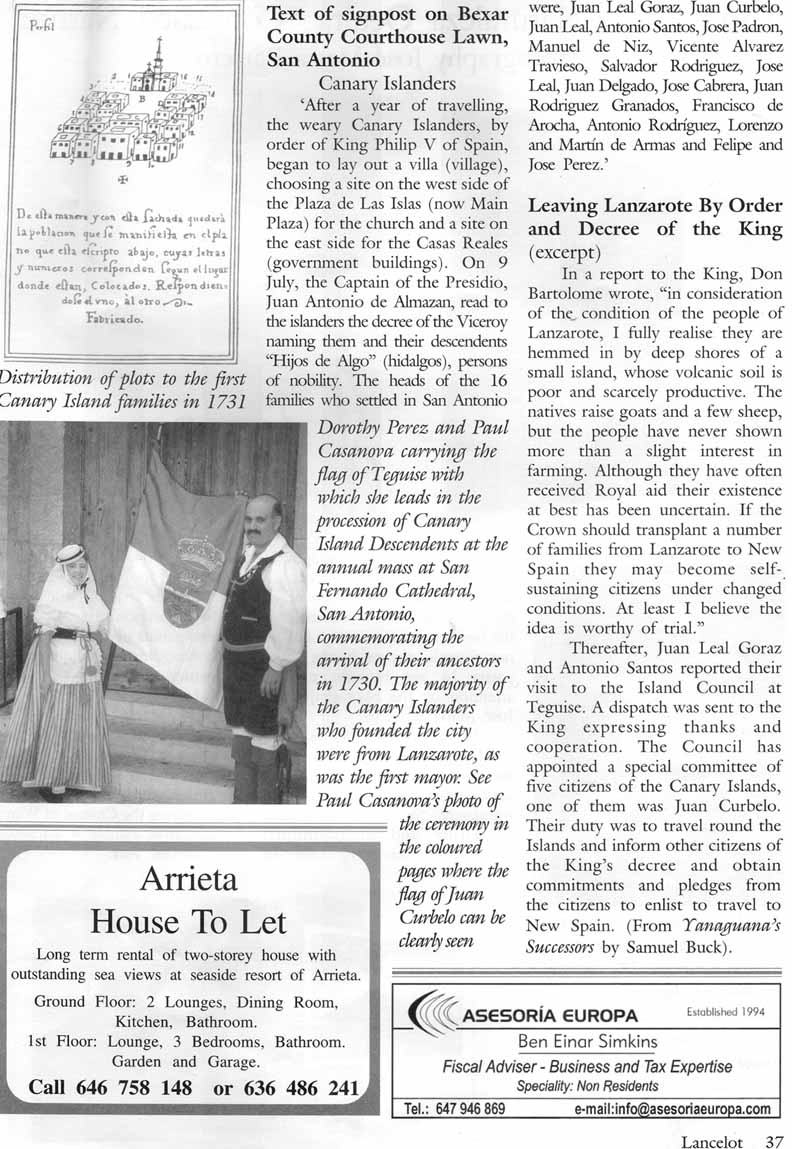
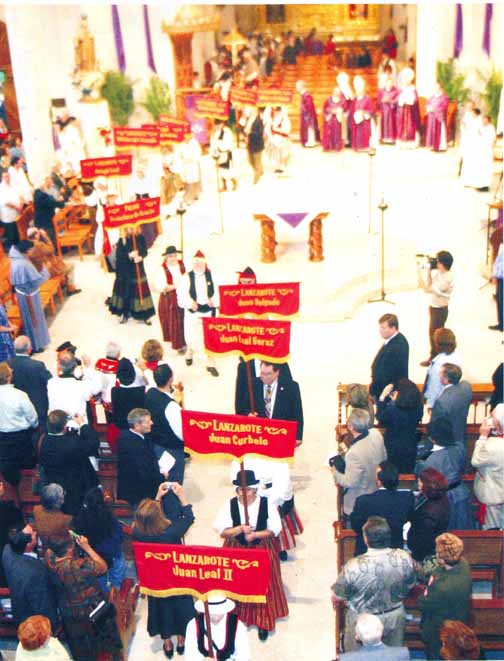 Reconnecting
with the Past
Reconnecting
with the Past